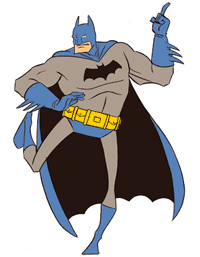 I spent much of a Sunday afternoon downloading Seventies and Eighties TV show theme songs from iTunes and editing them* into gain-consistent 20-second clips with tasteful fade-ins and -outs to serve as fillers between songs in the playlist I’m compiling for an upcoming ballroom dance. If this sounds like fun, you must be a geek, like me.
I spent much of a Sunday afternoon downloading Seventies and Eighties TV show theme songs from iTunes and editing them* into gain-consistent 20-second clips with tasteful fade-ins and -outs to serve as fillers between songs in the playlist I’m compiling for an upcoming ballroom dance. If this sounds like fun, you must be a geek, like me.
You may wonder why a ballroom dance would require the Batman theme as a transition between a fox trot and a waltz. It’s a good question, and the answer is simple: it doesn’t. But the interval between songs in a prerecorded playlist poses a challenge for the dance DJ or playlist organizer. Continuous music doesn’t allow the dancers to gracefully exit the floor to either change partners or take a breather; a comfortable gap solves this problem.
Now, if a live band has any kind of personality at all, it can fill the space with banter, but with a prerecorded playlist, the gap turns into an awkward silence. One solution is to provide a snippet of music to serve as a transition, such as this one:
Choosing the right music for this purpose presents its own challenge. A snippet of an actual dance song might lead some to believe that it was meant for, well, dancing, and that’s awkward in and of itself, as it fades out after twenty seconds. I’ve found that people respond well to something whimsical and completely different from the dance music, and old TV or movie theme songs seem to perfectly fit the bill.
Not only does this approach fill the silence while providing time for the dancers to do whatever they need to do between songs, it also provides a source of conversation as they attempt to identify some familiar jingles that they may not have heard in a long time. However, one must consider the likely demographics of the attendees, who may be more familiar with the theme from I Love Lucy than that from Friends (or vice versa).
The downside to using filler music, or for that matter, filler silence, is that there’s that much less music for dancing. A typical dance set for our group is about fifty minutes, with a ten minute break. That’s time enough for about fifteen continuous songs/dances, but a 20-second spacer after each song means that you’ll get one or two fewer dances per set. To be honest, most people don’t dance to every song in a set, so that’s not a big deal. And for those who have the energy to continue dancing, I’ll populate the breaks with music, although those songs tend to be out on the fringes of acceptable ballroom dance tunes (think polkas, or country 2 Step, or cumbias).
*I use an audio editing app called DSP Quattro for tasks like this. Now that Apple has dropped its DRM from music purchased from the iTunes Store, you can edit songs directly from your hard drive, although the app must first convert them from the native .m4a format to the .aiff format.
Dancing Batman illustration created by Jesse Lonergan
Discover more from The Fire Ant Gazette
Subscribe to get the latest posts sent to your email.
